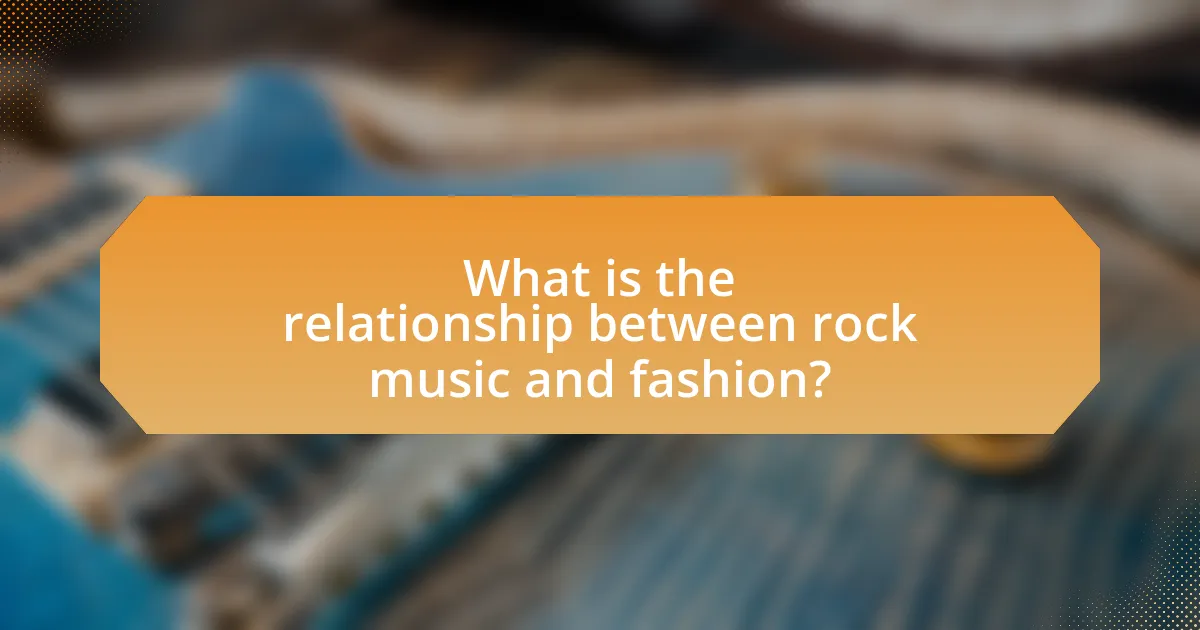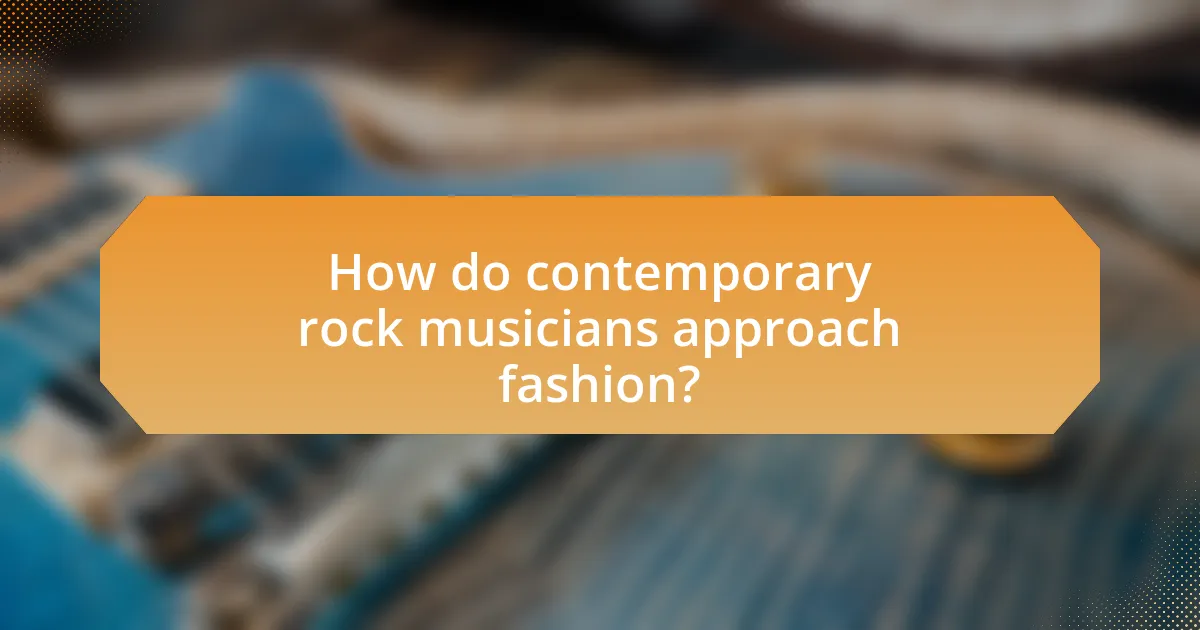The article explores the intricate relationship between rock music and fashion, highlighting how iconic musicians have influenced clothing styles and trends since the 1950s. It examines the evolution of fashion trends across different rock eras, from the rebellious leather jackets of the 1950s to the punk aesthetics of the 1970s and the grunge styles of the 1990s. Key style icons such as David Bowie, Jimi Hendrix, and Freddie Mercury are discussed for their significant contributions to rock fashion, while contemporary artists like Billie Eilish and Harry Styles are noted for their innovative approaches to style. The article also addresses the challenges musicians face in the fashion world, the impact of societal expectations, and the importance of personal narratives in shaping their fashion identities.

What is the relationship between rock music and fashion?
Rock music and fashion are intrinsically linked, as the genre has significantly influenced clothing styles and trends since its inception in the 1950s. Iconic rock musicians, such as Elvis Presley and later bands like The Rolling Stones and Nirvana, have shaped fashion by popularizing specific looks, such as leather jackets, ripped jeans, and graphic tees. This influence is evident in the way fans adopt these styles, creating a cultural identity that aligns with the rebellious spirit of rock music. The synergy between rock music and fashion continues to evolve, with contemporary artists like Billie Eilish and Harry Styles pushing boundaries and redefining gender norms in clothing, further solidifying the relationship between the two.
How has rock music influenced fashion trends over the decades?
Rock music has significantly influenced fashion trends over the decades by shaping styles that reflect the attitudes and identities of various musical movements. In the 1950s, rock and roll icons like Elvis Presley popularized leather jackets and slick hairstyles, which became symbols of rebellion. The 1960s saw the rise of psychedelic fashion, with artists like Jimi Hendrix and The Beatles promoting vibrant colors and eclectic patterns, influencing the counterculture movement.
In the 1970s, punk rock emerged, with bands like The Ramones and Sex Pistols introducing ripped clothing, safety pins, and combat boots, which challenged mainstream fashion norms. The 1980s brought glam rock, with artists like David Bowie and Madonna showcasing extravagant outfits, bold makeup, and androgynous styles, which encouraged self-expression.
The 1990s saw grunge music, led by bands like Nirvana, popularizing flannel shirts, distressed jeans, and a more casual aesthetic that rejected the excess of the previous decade. In the 2000s and beyond, rock music continued to influence fashion through various subgenres, with indie rock artists promoting vintage and thrift store styles, while pop-punk bands revived elements of earlier punk fashion.
Overall, rock music has consistently shaped fashion trends by reflecting cultural shifts and encouraging individual expression, making it a powerful force in the fashion industry.
What iconic fashion statements emerged from different rock eras?
Iconic fashion statements from different rock eras include the leather jackets and denim of the 1950s rockabilly scene, the flamboyant outfits and platform shoes of the glam rock movement in the 1970s, and the punk rock style characterized by ripped clothing and safety pins in the late 1970s and early 1980s. The 1950s saw artists like Elvis Presley popularizing the rebellious leather jacket look, which became synonymous with youth culture. In the 1970s, bands like David Bowie and T. Rex embraced extravagant costumes, influencing fashion with bold colors and textures. The punk rock era introduced a DIY aesthetic, with bands like the Sex Pistols showcasing a raw, anti-establishment style that included spiked hair and combat boots, fundamentally altering fashion norms.
How do musicians’ personal styles reflect their musical identities?
Musicians’ personal styles reflect their musical identities by visually expressing their artistic values, influences, and cultural backgrounds. For instance, rock musicians often adopt fashion elements such as leather jackets, band t-shirts, and distinctive hairstyles, which symbolize rebellion and individuality, core tenets of rock culture. Historical examples include David Bowie, whose flamboyant outfits and personas challenged societal norms, reinforcing his identity as a pioneer of glam rock. Similarly, Kurt Cobain’s grunge aesthetic, characterized by thrift store clothing and a disheveled appearance, mirrored the anti-establishment ethos of the 1990s alternative rock scene. These fashion choices serve not only as personal expression but also as a means of connecting with audiences who resonate with those identities.
Why is fashion important in the rock music industry?
Fashion is important in the rock music industry because it serves as a visual representation of the genre’s identity and values. The distinctive styles of rock musicians, such as leather jackets, band t-shirts, and unique hairstyles, contribute to the overall image of rebellion and individuality that defines rock culture. Historical examples include the punk movement of the 1970s, where fashion became a form of protest against societal norms, and artists like David Bowie, whose flamboyant outfits challenged gender norms and influenced countless fans. This interplay between fashion and music not only shapes public perception but also drives trends within the industry, making fashion an integral part of rock music’s cultural impact.
How does fashion contribute to an artist’s brand and image?
Fashion significantly contributes to an artist’s brand and image by serving as a visual representation of their identity and artistic expression. For instance, iconic rock artists like David Bowie and Freddie Mercury utilized distinctive fashion choices to create memorable personas that resonated with their music and audience. This alignment between fashion and music enhances an artist’s marketability, as unique styles can lead to increased visibility and recognition in the industry. Furthermore, studies indicate that artists who embrace bold fashion statements often experience higher engagement on social media platforms, reinforcing the connection between their visual style and overall brand appeal.
What role does visual presentation play in live performances?
Visual presentation plays a crucial role in live performances by enhancing the overall audience experience and reinforcing the artistic message of the performance. In rock music, for instance, visual elements such as stage design, lighting, and costumes are integral to creating an immersive atmosphere that captivates the audience. Research indicates that 70% of audience engagement during live performances is influenced by visual stimuli, demonstrating the importance of aesthetics in conveying the artist’s identity and emotional expression. Additionally, iconic performances, like David Bowie’s theatrical shows, exemplify how visual presentation can elevate a musical act into a memorable cultural event, solidifying the connection between music and visual artistry.
Who are the key style icons in rock music history?
Key style icons in rock music history include David Bowie, Jimi Hendrix, and Freddie Mercury. David Bowie revolutionized rock fashion with his androgynous style and theatrical personas, particularly during the Ziggy Stardust era. Jimi Hendrix is renowned for his flamboyant outfits and bold use of color, which reflected the psychedelic culture of the 1960s. Freddie Mercury, the frontman of Queen, is celebrated for his extravagant stage costumes and charismatic presence, influencing generations of performers. These artists not only shaped the visual identity of rock music but also left a lasting impact on fashion trends within the genre.
What unique styles did influential rock musicians bring to the forefront?
Influential rock musicians brought diverse styles to the forefront, including glam rock, punk, and grunge. Glam rock, popularized by artists like David Bowie and T. Rex, featured flamboyant costumes and theatrical performances, emphasizing individuality and self-expression. Punk rock, led by bands such as the Sex Pistols and The Ramones, introduced a raw, anti-establishment aesthetic characterized by leather jackets, ripped jeans, and DIY fashion, reflecting a rebellion against mainstream culture. Grunge, emerging from Seattle in the early 1990s with bands like Nirvana and Pearl Jam, showcased a more casual, unkempt style that included flannel shirts and combat boots, symbolizing disillusionment and authenticity. Each of these styles not only defined the musicians’ identities but also influenced broader fashion trends and cultural movements.
How have these icons shaped the fashion landscape beyond music?
Icons in rock music have significantly influenced the fashion landscape by introducing bold styles and trends that transcend their musical origins. For instance, artists like David Bowie and Freddie Mercury popularized androgynous fashion, challenging traditional gender norms and inspiring designers to create unisex clothing lines. Additionally, the punk movement, led by bands like The Ramones and Sex Pistols, brought elements such as leather jackets, ripped jeans, and graphic tees into mainstream fashion, which are now staples in casual wear. The impact of these icons is evident in contemporary fashion, where their styles are frequently referenced on runways and in streetwear, showcasing their lasting legacy beyond music.

How do contemporary rock musicians approach fashion?
Contemporary rock musicians approach fashion as a vital extension of their artistic identity, often blending personal style with cultural influences. They utilize fashion to express individuality, challenge norms, and connect with their audience, frequently drawing inspiration from various subcultures, historical styles, and current trends. For instance, artists like Billie Eilish and Harry Styles have been noted for their bold fashion choices that defy traditional gender norms, showcasing how contemporary rock musicians leverage fashion to make statements about identity and societal expectations. This approach not only enhances their public persona but also reflects broader cultural conversations about self-expression and authenticity in the music industry.
What current trends are emerging in rock music fashion?
Current trends in rock music fashion include a resurgence of vintage aesthetics, oversized silhouettes, and a blend of punk and high fashion elements. Vintage band tees and distressed denim are popular, reflecting a nostalgic nod to the 70s and 80s rock scene. Oversized jackets and trousers are being embraced, often layered with graphic tees, creating a relaxed yet edgy look. Additionally, designers are incorporating punk-inspired accessories, such as studded belts and combat boots, into contemporary collections, showcasing the influence of rock culture on mainstream fashion. This trend is validated by recent runway shows where brands like Balenciaga and Gucci have featured rock-inspired pieces, indicating a strong connection between rock music and current fashion movements.
How are modern rock artists blending genres in their fashion choices?
Modern rock artists are blending genres in their fashion choices by incorporating elements from punk, hip-hop, and electronic styles. This fusion is evident in the use of oversized silhouettes, vibrant colors, and eclectic accessories, which reflect a diverse cultural influence. For instance, artists like Yungblud and Halsey often mix traditional rock attire, such as leather jackets, with streetwear elements like graphic tees and sneakers, showcasing a contemporary approach to rock fashion. This trend highlights the evolving nature of rock music, where genre boundaries are increasingly blurred, allowing for a more inclusive and varied aesthetic.
What sustainable fashion practices are being adopted by rock musicians?
Rock musicians are adopting sustainable fashion practices such as using eco-friendly materials, promoting upcycled clothing, and collaborating with sustainable brands. For instance, artists like Billie Eilish have been known to wear outfits made from recycled materials, while others, like Pearl Jam, have partnered with brands that focus on sustainable production methods. These practices not only reduce environmental impact but also raise awareness about sustainability in the fashion industry, reflecting a growing trend among musicians to align their public personas with eco-conscious values.
How do collaborations between musicians and fashion designers manifest?
Collaborations between musicians and fashion designers manifest through co-created clothing lines, stage outfits, and promotional campaigns that blend music and fashion aesthetics. For instance, musicians often partner with designers to create unique apparel that reflects their artistic identity, such as Beyoncé’s collaboration with Adidas for the Ivy Park line, which combines athletic wear with high fashion. These partnerships not only enhance the visual representation of the music but also drive sales and brand visibility, as seen in the success of Rihanna’s Fenty line, which generated significant revenue and acclaim. Such collaborations exemplify the intersection of cultural influence, where both parties leverage their audiences to expand their reach and impact in their respective industries.
What are some notable partnerships that have influenced rock fashion?
Notable partnerships that have influenced rock fashion include the collaboration between designer Vivienne Westwood and the Sex Pistols, which helped define punk aesthetics in the 1970s. This partnership introduced elements like torn clothing and provocative graphics, shaping the visual identity of punk rock. Another significant partnership is between David Bowie and designer Kansai Yamamoto, whose flamboyant costumes in the 1970s contributed to the glam rock movement, emphasizing theatricality and bold colors. Additionally, the collaboration between the band Queen and designer Zandra Rhodes in the late 1970s brought a unique blend of theatrical fashion and rock style, further influencing the genre’s visual culture. These partnerships not only created iconic looks but also established a lasting impact on the intersection of fashion and rock music.
How do these collaborations impact both the music and fashion industries?
Collaborations between the music and fashion industries significantly enhance brand visibility and cultural relevance for both sectors. For instance, when musicians partner with fashion designers, they create unique merchandise that not only promotes the artist but also elevates the designer’s profile. A notable example is the collaboration between rapper Kanye West and Adidas, which resulted in the Yeezy brand, generating over $1 billion in revenue and reshaping sneaker culture. This synergy allows fashion to tap into the emotional connection fans have with music, while musicians gain access to new markets and audiences, ultimately driving sales and trends in both industries.
What challenges do rock musicians face in the fashion world?
Rock musicians face significant challenges in the fashion world, primarily due to the pressure to maintain a distinct personal brand while navigating industry trends. This pressure often leads to conflicts between artistic expression and commercial viability, as musicians must balance their unique style with market demands. Additionally, the fast-paced nature of fashion can make it difficult for rock musicians to keep up, as trends can change rapidly, requiring constant adaptation. The expectation to collaborate with high-profile designers can also create barriers, as not all musicians have access to these networks or the financial resources to invest in high-end fashion.
How do societal expectations influence musicians’ fashion choices?
Societal expectations significantly influence musicians’ fashion choices by dictating trends and norms that artists feel pressured to conform to. For instance, in rock music, the expectation to embody a rebellious image often leads musicians to adopt edgy styles, such as leather jackets and distressed jeans, which reflect a countercultural aesthetic. This influence is evident in the fashion choices of iconic rock bands like The Rolling Stones and Nirvana, whose styles were shaped by societal perceptions of masculinity and rebellion during their respective eras. Additionally, research indicates that musicians often use fashion as a means of self-expression while simultaneously adhering to industry standards, which can limit their creative freedom. Thus, societal expectations play a crucial role in shaping the visual identity of musicians within the rock genre.
What barriers exist for diversity and representation in rock fashion?
Barriers for diversity and representation in rock fashion include systemic industry biases, limited access to platforms for marginalized voices, and a lack of inclusive marketing strategies. Systemic biases often favor established norms that prioritize certain aesthetics and demographics, thereby sidelining diverse expressions. Additionally, marginalized designers and artists frequently encounter challenges in gaining visibility and support, which restricts their ability to influence the fashion landscape. Research indicates that the fashion industry has historically underrepresented people of color and LGBTQ+ individuals, contributing to a narrow definition of what is considered “rock fashion.” This lack of representation perpetuates stereotypes and limits the cultural richness that diversity can bring to the genre.
![]()
What insights can we gain from conversations with style icons in the rock industry?
Conversations with style icons in the rock industry reveal the profound connection between music and fashion, showcasing how personal expression influences cultural trends. These icons often discuss their unique approaches to style, emphasizing authenticity and individuality, which resonate with fans and inspire new generations. For instance, David Bowie’s flamboyant costumes and persona not only defined his career but also challenged societal norms, illustrating the power of fashion in shaping identity. Additionally, insights into the creative processes behind iconic looks, such as those of Jimi Hendrix or Janis Joplin, highlight the role of visual aesthetics in enhancing musical performances and audience engagement. Such discussions provide valuable perspectives on the evolution of rock fashion and its impact on broader cultural movements.
What common themes emerge from interviews with rock fashion icons?
Common themes that emerge from interviews with rock fashion icons include self-expression, rebellion against societal norms, and the influence of music on personal style. Rock fashion icons often emphasize the importance of individuality, showcasing how their unique styles reflect their personal identities and artistic visions. Additionally, many discuss the role of fashion as a form of protest or defiance, highlighting how their clothing choices challenge conventional standards. The interplay between music and fashion is also a recurring topic, with icons noting how their musical influences shape their aesthetic choices, creating a symbiotic relationship between the two realms.
How do these icons perceive the evolution of rock fashion?
These icons perceive the evolution of rock fashion as a dynamic reflection of cultural shifts and personal expression. They highlight that rock fashion has transitioned from the rebellious styles of the 1960s and 1970s, characterized by leather jackets and denim, to more diverse and inclusive representations that incorporate various influences, including punk, glam, and streetwear. For instance, David Bowie’s flamboyant outfits in the 1970s challenged gender norms and inspired future generations, while contemporary artists like Billie Eilish blend casual wear with high fashion, showcasing a shift towards comfort and individuality. This evolution illustrates how rock fashion continues to adapt, mirroring societal changes and the artists’ personal identities.
What advice do they offer to aspiring musicians regarding style?
Aspiring musicians are advised to develop a unique style that reflects their individuality and authenticity. This emphasis on personal expression is crucial in the competitive landscape of the music industry, where standing out can significantly impact a musician’s success. Style icons in rock music often highlight the importance of blending personal influences with current trends, ensuring that the musician’s appearance resonates with their musical identity. For instance, many successful artists have crafted their image by incorporating elements from various subcultures, which not only enhances their visual appeal but also connects them with diverse audiences.
How do personal stories shape the fashion narratives of rock musicians?
Personal stories significantly shape the fashion narratives of rock musicians by influencing their style choices and public personas. For instance, musicians often draw from their life experiences, struggles, and cultural backgrounds to create a unique aesthetic that resonates with their audience. This connection is evident in the fashion of artists like David Bowie, whose alter ego Ziggy Stardust reflected his exploration of identity and sexuality, thereby impacting the glam rock movement. Additionally, Kurt Cobain’s grunge style, characterized by thrift store finds and a casual demeanor, mirrored his disillusionment with mainstream culture, further solidifying the genre’s identity. These personal narratives not only inform individual fashion choices but also contribute to broader trends within the rock music scene, illustrating how deeply intertwined personal stories and fashion are in shaping the narratives of rock musicians.
What experiences have influenced their fashion choices?
Experiences that have influenced fashion choices in the context of rock music include exposure to iconic musicians, cultural movements, and personal milestones. For instance, many fashion icons in the rock industry cite their admiration for legendary artists like David Bowie and Jimi Hendrix, whose unique styles challenged societal norms and inspired individual expression. Additionally, cultural movements such as punk and grunge have significantly shaped fashion trends, encouraging bold and unconventional attire. Personal experiences, such as attending concerts or participating in music festivals, further reinforce these influences by allowing individuals to engage with the vibrant fashion culture surrounding rock music.
How do these narratives resonate with fans and the broader culture?
Narratives in rock music and fashion resonate with fans and the broader culture by reflecting shared values, emotions, and social movements. For instance, the rebellious spirit of rock music often aligns with youth culture’s desire for freedom and self-expression, as seen in the 1960s counterculture movement, which challenged societal norms. This connection is further evidenced by the influence of iconic figures like David Bowie and Jimi Hendrix, whose unique styles and personas have inspired generations, shaping fashion trends and cultural attitudes. Additionally, the integration of rock music into fashion events, such as the Met Gala, highlights its significance in contemporary culture, reinforcing the idea that music and style are intertwined in expressing identity and social commentary.
What practical tips can be learned from style icons in rock music?
Style icons in rock music offer practical tips such as embracing individuality, experimenting with bold fashion choices, and layering clothing for a unique look. For instance, artists like David Bowie and Freddie Mercury are known for their distinctive styles that reflect personal identity and creativity. Additionally, the use of accessories, such as statement jewelry and hats, can elevate an outfit, as seen in the fashion of Jimi Hendrix and Joan Jett. These icons demonstrate that confidence in one’s style can make a significant impact, encouraging fans to express themselves authentically through their wardrobe choices.
How can musicians develop their unique fashion identity?
Musicians can develop their unique fashion identity by experimenting with various styles, incorporating personal elements, and drawing inspiration from their musical influences. This process often involves a combination of self-expression and cultural references, allowing artists to create a distinctive look that resonates with their audience. For instance, David Bowie famously blended glam rock with avant-garde fashion, establishing a unique identity that influenced generations. By actively engaging with fashion trends and collaborating with designers, musicians can further refine their style, ensuring it aligns with their artistic vision and persona.
What are the best practices for integrating fashion into a music career?
The best practices for integrating fashion into a music career include developing a unique personal style, collaborating with fashion designers, and leveraging social media for visibility. Artists should focus on creating a signature look that reflects their musical identity, as seen with icons like David Bowie and Lady Gaga, who used fashion to enhance their artistic personas. Collaborating with established designers can elevate an artist’s brand, as demonstrated by musicians like Rihanna, who launched successful fashion lines. Additionally, utilizing platforms like Instagram and TikTok allows artists to showcase their fashion choices and connect with fans, driving engagement and expanding their influence in both music and fashion industries.


